Firstly: Welcome to the new site.
Secondly: I apologize for any weirdness in the formatting of this entry. New site, you see.
Finally: Are the images too big? I like chunky pixels but maaaaaybe this is going overboard. I dunno. Edit: Yes, too big. Back to 512×448.
By stepping into the vast stone maw of Norfair’s Ridley effigy, you’re obviously taking this journey back to where it started. Now, I don’t mean that literally, since the place the game began is now a minor constellation of glittering, radioactive, metal dust where once existed a space colony. No, I mean you’re going after the jerk who set events into motion by killing a bunch of scientists and kidnapping a baby metroid. Ridley, man. What a jerk.
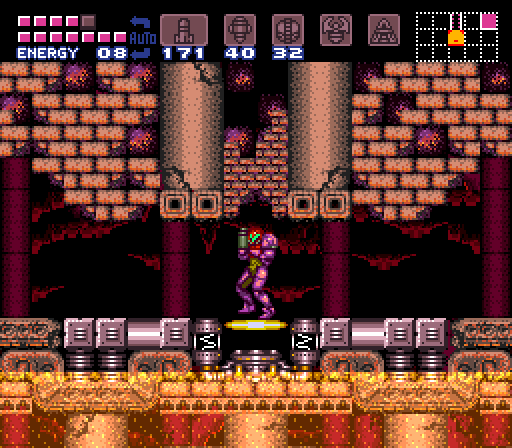
Unlike in the first game, Ridley doesn’t reside in an area specifically designated as his lair; instead, it’s the lower extension of Norfair. However, for all intents and purposes, it feels like a different place than upper Norfair. This further descent into Zebes takes you to a hotter, more intense region of the underground, where magma becomes pale and translucent from its intensity; the Gravity Suit can’t withstand its heat. The music changes to an intense, driving beat – probably the most memorable track in the game, thanks to the insistent drone of percussion and the eerie chanting that carries the melody. There’s something primal about this area, with its vaguely Mesoamerican visual motifs, its searing flames, and its bold music. Usually in sci-fi epics, the technology grows in sophistication as the story reaches its climax, but not here; instead, you feel like you’ve entered a more primitive world (befitting your saurian opponent), and the atmosphere becomes all the more tense for the change.
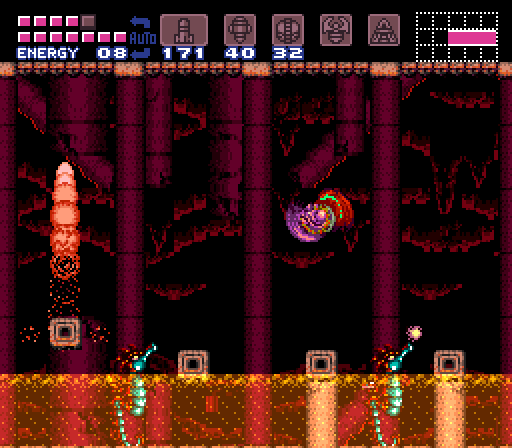
Lower Norfair reprises a lot of familiar hazards and situations, increasing their difficulty. Platforms become smaller, environmental traps grow more aggressive, enemies move more quickly. Much of what you encounter in this region you’ve seen before, but not at such a high threat level. To add to the intensity of this sequence, save rooms become scarce once you descend into the gullet of Ridley’s effigy. There’s only one in this entire extended sequence, and it’s a fair distance from either of the bosses.
Perhaps the most significant change Lower Norfair brings to the action is a strict sense of linearity. The progressively more open level design and structure of Super Metroid slowly built up to Maridia, a vast and meandering region that required considerable backtracking to complete in its entirety and which rewarded straying from the critical path with all sorts of interesting extras. That ends the moment as you descend the elevator from upper Norfair; while you can advance a few rooms to the right of the elevator landing, you’ll quickly hit a dead end and be forced to return the other way. The route to Ridley isn’t about player agency. The most you can do here is wander a room or two off the main path to collect an item, but really there’s only one way to the inevitable showdown.
The biggest, most dangerous non-metroid enemies in the game reside here. Space Pirates are everywhere, along with larger, stronger versions of monsters like Dessgeega and Holtz. The layout of the environment offers no quarter, either.
For instance, there’s the room that appears to be a complete dead end, offering nothing but a vast pit of ultra-heated magma. But if you use the Space Jump to cross the magma and detonate a Power Bomb…
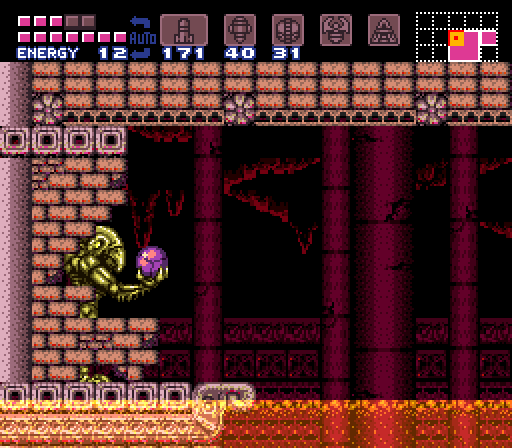
…you’ll reveal another mysteriously helpful Chozo statue, which lowers the lava level for you to let you advance. The statue isn’t completely hidden, but it’s obscured heavily enough that you need to be attentive in order to notice it. And once you do expose it, Super Metroid expects you to be able to dredge up your memories of the Wrecked Ship area in order to figure out what to do here.
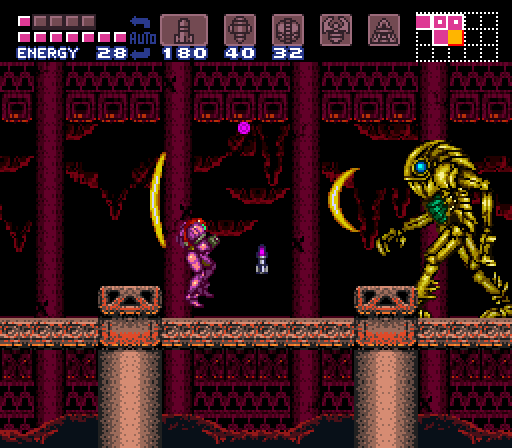
As a reward for solving the mystery here, you’re dropped into a battle with another Torizo guardian statute. If you remember your first encounter with one of these guys – all the way back at the very beginning of the game – you’ll recall that it performs a couple of different attacks and is only vulnerable in its chest. None of that has changed; this Torizo uses the same attacks as the previous one. It is, however, much more powerful, with devastating energy beams and a tendency to be much more active in leaping about the room, greatly increasing your chances of an injurious collision.
What really makes this encounter tricky, however, is the fact that you can’t use your missiles against this guy. Only the charged plasma beam works. If you fire an expendable projectile at him….

…he does something no other enemy in the game can do: He breaks the two-dimensional plane of the action and pivots into the background, neatly sidestepping your attacks. This is a surprising defensive tactic – and a cool detail as well. You didn’t really see 2D action games make use of the third dimension in this pre-polygonal era; there were the chain-link fence “layers” in Super Mario World, but that was really the only precedent for this that comes to mind. This encounter breaks the “rules” of the game to add an extra touch of challenge… but happily, it doesn’t break them in a way that damages the game.
I’m also reminded that if you fire Super Missiles at the Torizo, he doesn’t simply side-step them; he plucks them from the air and throws them back at you. Of course, this can be exploited; while he’s standing there chucking your own projectiles back at you, you can lay into him for a pretty easy win.
It’s not often you see a game cheat like this, changing mechanics on a fundamental level, without diminishing or cheapening the whole affair. In this case, though, the Torizo’s little maneuver is basically just a cosmetic embellishment for a standard trait among many enemies (weapon-specific invulnerability). The designers could just as easily have made missiles simply bounce off this guy… but they didn’t. They applied a special, unique detail to this one enemy to help communicate ineffectual attacks in an interesting way and encourage you to try different tactics. And, at the same time, the Torizo’s ability to work outside the rules governing Super Metroid convey the message that you’re dealing with high-level foes, that here in the heart of the Space Pirates’ lair all the rules you’ve taken for granted have been thrown out and there’s no refuge in the comfort of precedent. It’s a brilliant detail that didn’t need to exist, but its existence adds a great deal to the game.
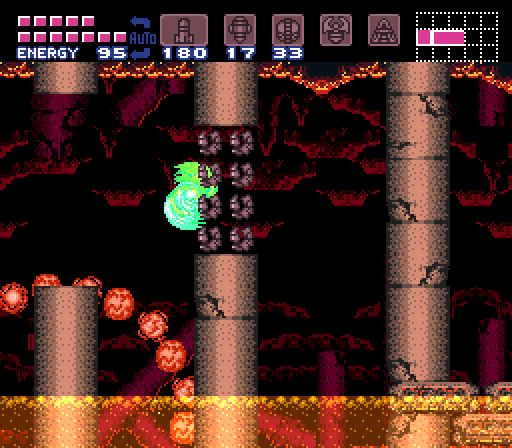
Upon defeating the Torizo, you collect the Screw Attack. In previous games, the Screw Attack was simply a weapon, but Super Metroid is highly scrupulous about making sure all weapons double as tools; in this room, you encounter walls that can only be broken through with Screw Attack contact. And even if you could shoot through the columns, doing so would be too slow. Magma steadily rises as you work your way through this room, forcing you to step up your speed or risk dying and losing your victory over the Torizo… and the Screw Attack is the only way to accomplish this. Again, this echoes something we’ve seen before – namely, the rising lava you had to race once you collected the Speed Booster – but here it takes a longer, more difficult form with greater potential for failure.
However, this was a warm-up, really. The hardest scenarios are yet to come.
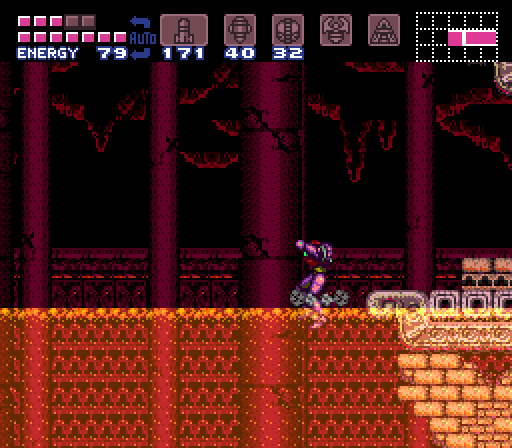
I like the big images fine, but I’m pretty fond of pixels myself.
If you throw super missiles at the Torizo, he breaks the rules even harder; he’ll catch the stupid things and throw them back at you. On the plus side, while he’s doing that, you can hammer him with either more super missiles or your regular missiles, and hit him as normal.
So you can brute-force him without the charge beam, it’s just not advised.
Oh, man, I didn’t even notice that. Awesome. I’ll amend the post later.
…oh, there it is. Dang, should have refreshed before posting below. =P
In a way, it’s almost like this is the true final stage of the game, and Tourian is just for show; a set piece to cap off the adventure, if you will.
Also, I was thinking the Torizo could catch missiles and throw them back. Am I thinking of another enemy, or even another game?
The format looks great on my ipad.
Yeah, he can. I’m not sure if I’ve ever used regular missiles or seen his sidestep move, actually. I think I usually just spam supers at him until he dies.
Regarding the format, I’m okay with the chunky pixels. Is this a 3x resize, perchance? 2x might be sufficient (that’s what I used in my days at 1UP), but then again, that would probably require other formatting changes…
Meh, I’m no good at determining these things.
Yeah, this is 3X, and it’s too much. Definitely going back to 2X after this.
Parish! Can you axe, shrink or move the cover-up sidebar please? It makes it impossible to read this site on my phone while I’m supposed to be doing more important and/or worthwhile things.*
*more important than super metroid? Forgive me for i have sinned~!
There’s an interesting tidbit about the Chozo that drains the lava for you. If you manage to make it into Lower Norfair without obtaining the Space Jump then that Chozo statue will not activate. The lava doesn’t drain and the one block obstruction stays put so you couldn’t even brute force your way through the energy drain. You can turn around and go right past the elevator and through some Power Bomb blocks to progress through the area, though.
But this means the Screw Attack is off-limits to you, unless you can pull off the glitch that allows you to open a Super Missile gate from the wrong side, and it’s probably easier to get into Lower Norfair without the Space Jump than it is to do that.
It’s really strange that they accounted for not having the Space Jump in this way. Not having it doesn’t affect the Screw Attack in any way, that I’m aware of, but they consciously decided to lock it off from you (barring the green gate glitch of course) if you pull off the tricky maneuver necessary to get into Lower Norfair without the Space Jump. It’s quite strange.
As for how to get into Lower Norfair without it, there’s several methods. The one I finally managed to do on an old playthrough involved abusing the water physics. Stand under the high ledge, spin jump and immediately press start to open the inventory and deactivate the Gravity Suit. Samus will then, for some reason, rocket upward. She’ll be unable to break the surface of the acid, though, so right before you get to the ledge you reactivate the Gravity Suit. Then you have to wall-jump off the one-block ledge to actually make it out of the lava. It is very tough to pull off, and according to Nintendo your reward is no Screw Attack. Power Bombing your way through the rising lava room and anywhere else you’d breeze through otherwise was a challenge in itself.
I’m pretty sure there are a least a few SNES games that make ok use of layers. I know Super Castlevania has you switching between layers in a few areas (most notably the first level), though this seems to work pretty similarly to the Super Mario World fences.
I can’t remember others off hand but I swear there were a couple. I seem to recall at least one instance of a game having enemies that would start as the background layer and then charge/attack in the front layer… unless this wasn’t an SNES game - so many games afterwards used similar sprite styles (some PSX, GBA, DS, etc - especially when it comes to Konami & Capcom stuff) that it all kind of blends together after awhile 😛